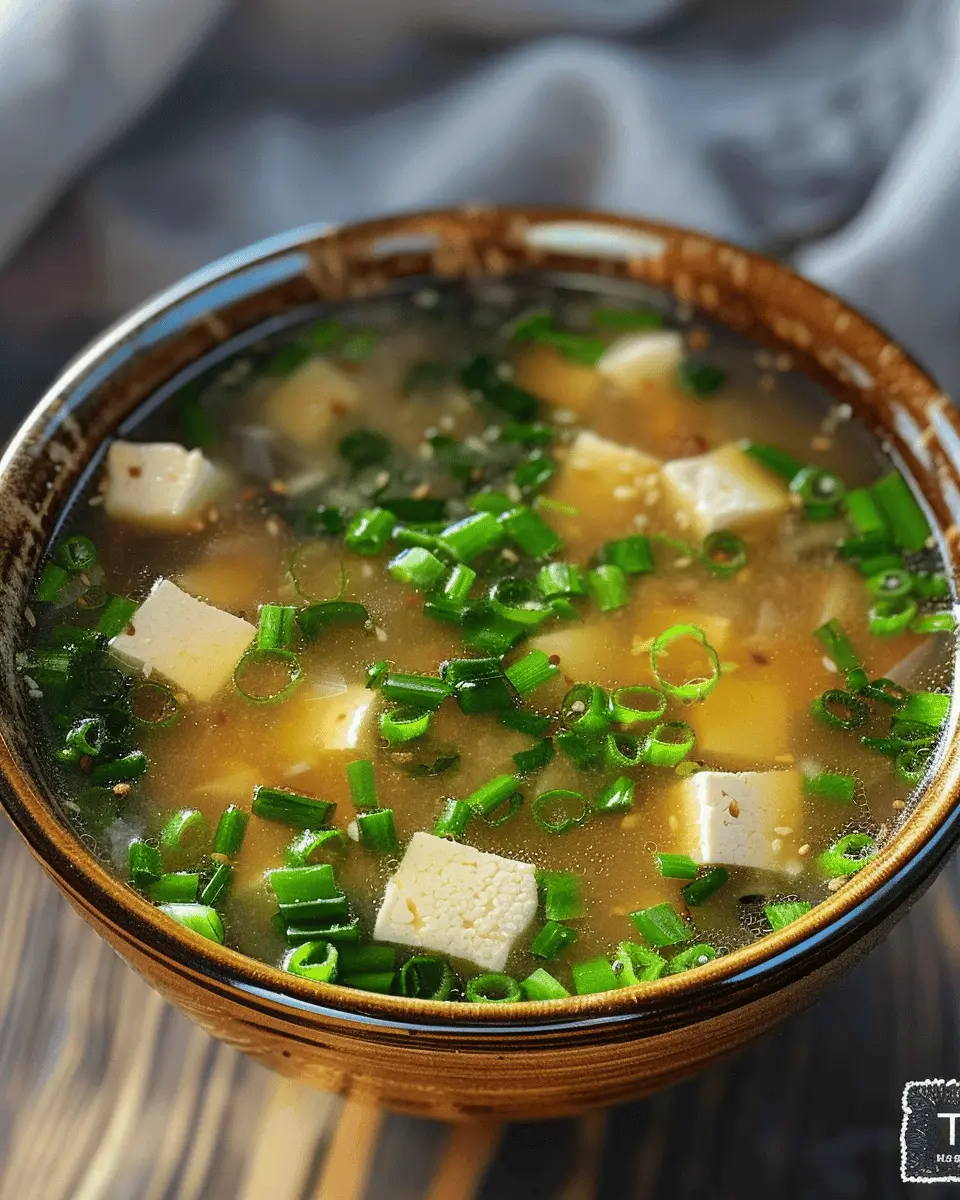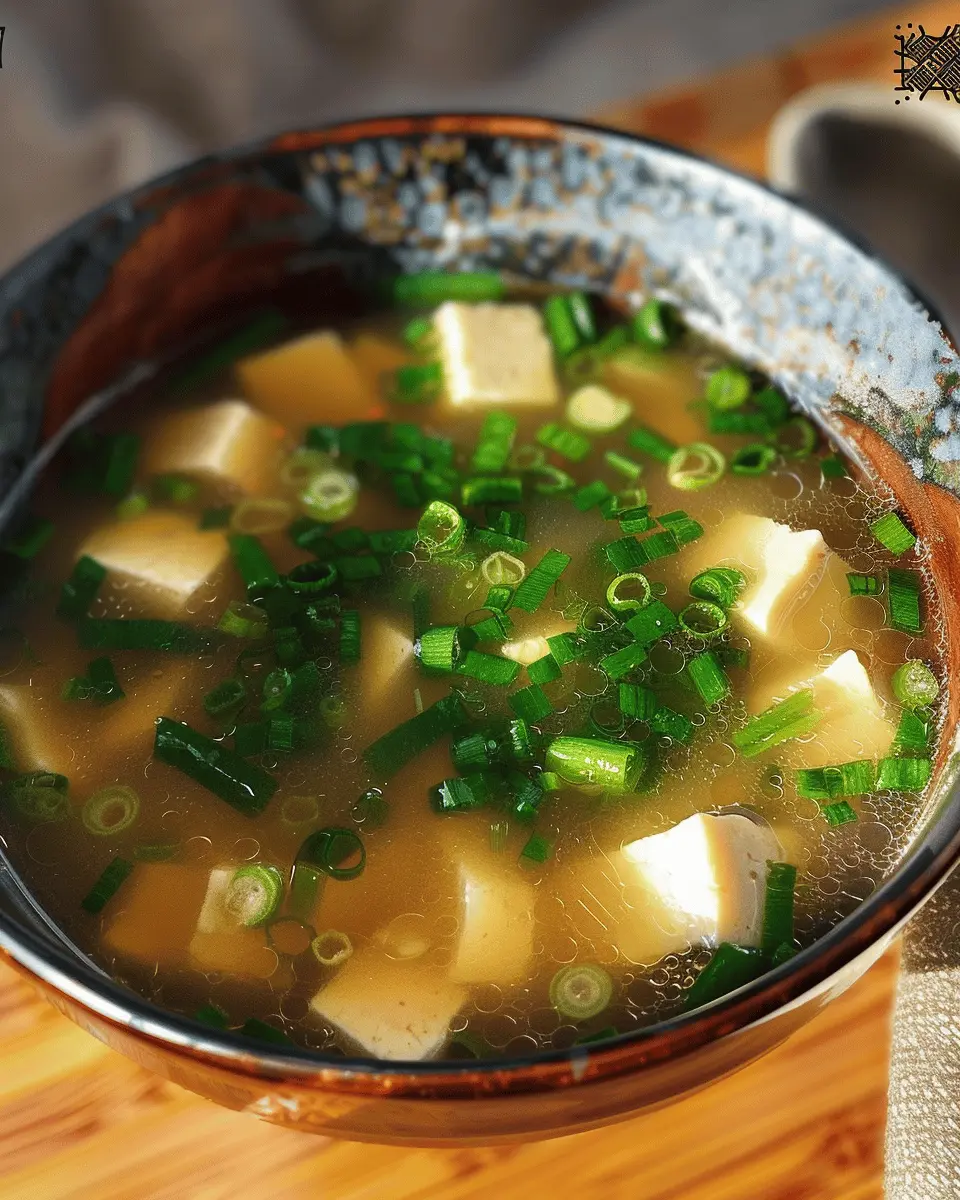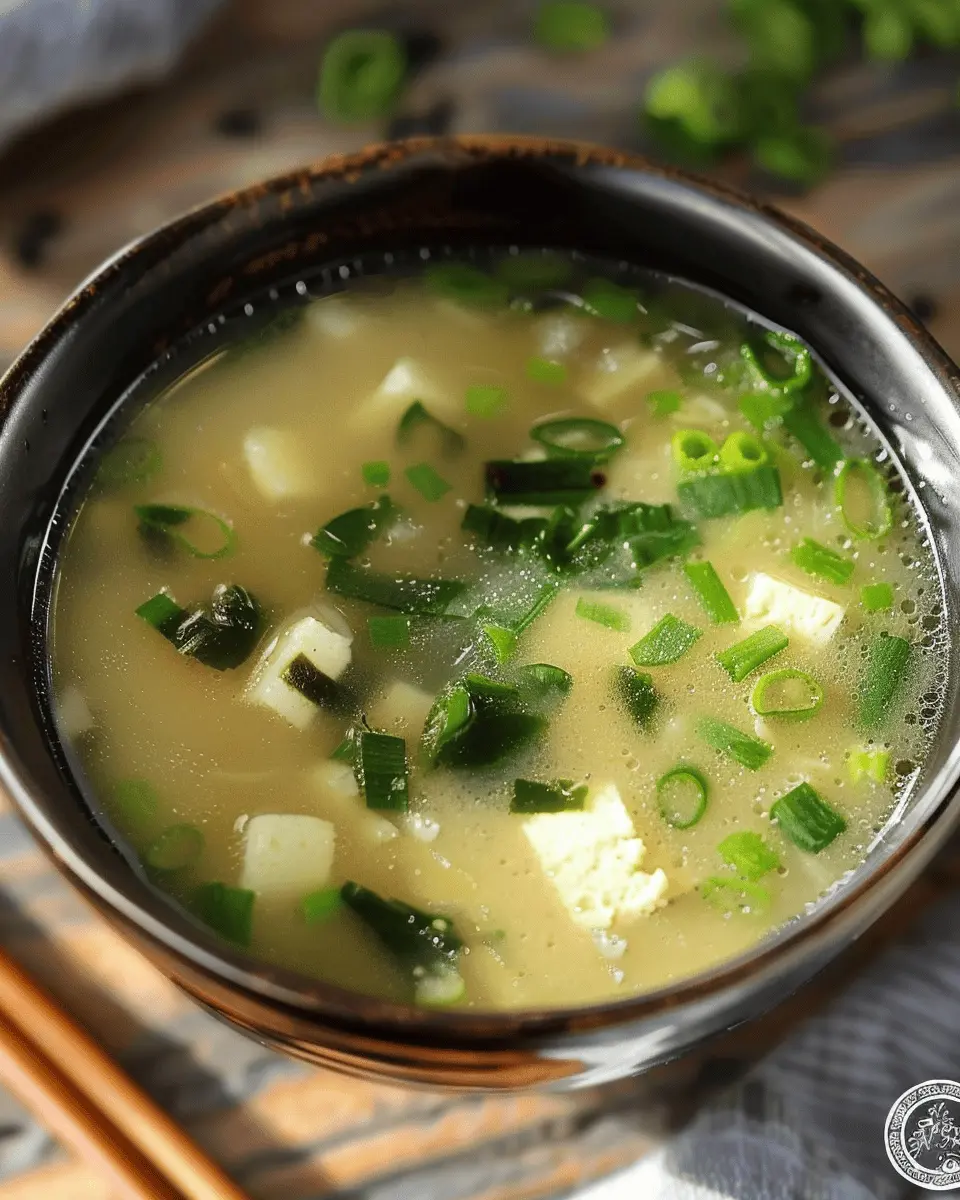Introduction to Homemade Miso Soup
When it comes to enjoying a bowl of savory miso soup, you might think takeout is the easiest option. However, there’s something truly special about crafting your own homemade miso soup. Not only does it allow you to control the ingredients, but it also provides an opportunity to make a delightful dish that surpasses anything you could find in a restaurant.
Why Homemade is Better Than Takeout?
-
Quality Control: You decide what goes into your bowl. By using fresh ingredients, you can avoid preservatives and artificial flavors that are often in takeout options. A prime example is when using high-quality miso paste—often made from organic soybeans—which will give your soup a robust, authentic flavor.
-
Customization: Have a favorite veggie or a specific protein like turkey bacon or chicken ham? You can easily swap and add different ingredients according to your taste. Want to omit tofu? Go for it! The beauty of homemade miso soup lies in its flexibility.
-
Budget-Friendly: Let’s face it, ordering takeout can add up, especially if you’re indulging frequently. Cultivating your own miso soup at home means you can enjoy this delicacy as often as you want without breaking the bank. A small investment in ingredients can yield numerous servings, making it a smart choice for budget-conscious young professionals.
-
Healthier Choices: By preparing your own soup, you can make it as nutritious as you want. Want it low-sodium or gluten-free? No problem! Creating a personalized homemade miso soup ensures it aligns with your dietary preferences.
-
Therapeutic Experience: Cooking can be a form of therapy. Engaging in the blending of flavors and savoring the fragrant aroma of the ingredients simmering on the stove can bring a sense of accomplishment and tranquillity to your day.
Next time you crave that warm, comforting taste of miso soup, consider the homemade route. It’s not just about feeding the body; it’s about feeding the soul. For more culinary inspiration, check out Food52’s guide on the best miso pastes to elevate your soup-making endeavor. Let’s dive into the recipe that will transform your kitchen into a peaceful retreat with every spoonful!

Ingredients for Homemade Miso Soup
Creating a comforting bowl of homemade miso soup is easier than you might think! Let’s gather some simple yet flavorful ingredients that will bring warmth to your kitchen.
Essential Ingredients
- Miso Paste: This is the star of the show! Opt for white or yellow miso for a milder taste, or red miso for a bolder flavor.
- Dashi Alternative: Instead of traditional dashi, you can use a combination of vegetable broth or water with a splash of soy sauce for depth.
- Tofu: Choose firm or soft tofu, depending on your texture preference. It adds protein and creaminess.
- Green Onions: Chopped green onions not only enhance flavor but also add a pop of color to your soup.
- Seaweed: Wakame is a popular choice. It’s nutritious and adds a lovely umami flavor.
- Vegetables: Feel free to add mushrooms, spinach, or even julienned carrots! These veggies make your homemade miso soup heartier and healthier.
Optional Add-Ins
- Turkey Bacon or Chicken Ham: For those who enjoy a hint of meat, these alternatives add smoky flavor without overshadowing the miso.
When making homemade miso soup, the focus is on balancing flavors and enjoying the delightful process of cooking. Ready to dive into the full recipe? Let’s get started!
Step-by-step Preparation of Homemade Miso Soup
Miso soup is one of those comforting dishes that can transport you straight to your favorite sushi bar or a cozy ramen joint. What if I told you that making homemade miso soup is doable right in your kitchen? Here’s how to prepare it step-by-step, making this dish not just a treat for your taste buds but also a fun cooking experience.
Gather your ingredients
Before we dive in, let’s make sure you have everything you need. Here’s your shopping list:
- 4 cups of vegetable broth (try low-sodium for better control over flavor)
- 3 tablespoons of miso paste (white or yellow is preferable for a milder flavor)
- 1 cup of firm tofu (cut into small cubes)
- 1 cup of kale (chopped)
- 4 green onions (sliced)
- Optional add-ins: mushrooms, seaweed, or even some chopped Turkey Bacon for an extra kick.
Feel free to get creative! This recipe is incredibly versatile, and a great way to use up any veggies you might have hanging around. As you prepare your ingredients, it’s a good time to reflect on how cooking can be both meditative and joyful. Did you know that cooking can reduce stress? According to a study from the Journal of Positive Psychology, engaging in creative activities helps improve emotional well-being. So, let’s get started!
Bring the broth to a boil
In a medium-sized pot, pour in your vegetable broth and place it over medium-high heat. We want to get that broth bubbling, so be patient! Once it reaches a rolling boil, reduce the heat a bit to maintain a gentle simmer. This is your base, and the heart of your homemade miso soup, so treat it right.
While you wait for it to boil, you can practice your knife skills if you haven’t already chopped those veggies. Slicing green onions is a breezy way to improve those dexterity skills, plus the smell is absolutely delightful!
Add in green onions and kale
Once your broth is simmering, it’s time to add in your kale and green onions. Stir them in gently, letting the vibrant colors brighten up your pot. Both kale and green onions are packed with nutrients; for example, kale is loaded with vitamins A, K, and a good dose of iron. This not only boosts the flavor but also incorporates a powerhouse of health benefits into your homemade miso soup.
Let these simmer for about five minutes, just until the kale is tender. Be sure to keep an eye on it, as you want those ingredients to stay crisp and vibrant.
Incorporate the tofu
After your greens have softened, it’s time to add in the star of the show: the tofu! Carefully toss in your cubed firm tofu, which adds a creamy texture that’s critical for a satisfying soup. Tofu is an excellent source of protein and can soak up all those delightful flavors from the broth and veggies.
Allow everything to simmer again for another five minutes. The goal here is to warm the tofu through without compromising its delicate texture. Just imagine the comforting aroma wafting through your kitchen—heavenly!
Mix the miso paste
Now for the grand finale: mixing in the miso paste. Start by taking a small bowl and adding the miso paste with a few tablespoons of hot broth. Mixing it separately helps prevent clumping and ensures an even blend in your homemade miso soup. Once smooth, stir this mixture back into the pot.
Keep in mind that miso is rich in probiotics and has been linked to several health benefits, including better digestion and improved immune function. So not only are you making a delicious soup, but you’re also nourishing your body.
Let the soup simmer for just a couple more minutes — and then, voila! Your homemade miso soup is ready to serve. Ladle it into bowls, garnish with extra green onions if desired, and—enjoy the warmth and familiarity of a dish that’s as nourishing as it is delicious!
Feeling inspired? Give this easy recipe a try, and let the flavors whisk you away to Japan—all without having to leave your kitchen. Cooking is an adventure, and the possibilities are endless! For more about the benefits of miso and other recipe ideas, check out this detailed guide on Miso Health Benefits. Happy cooking!

Variations of Homemade Miso Soup
Creating your own homemade miso soup opens the door to myriad delicious variations. The best part? You can easily adapt it to suit your dietary preferences and the ingredients you have on hand. Let’s explore some exciting ways to mix up this classic dish.
Adding Different Vegetables
One of the standout features of homemade miso soup is its flexibility with vegetables. Depending on the season or what you have in your fridge, you can enhance both the flavor and nutrition. Some popular choices include:
- Spinach or Kale: These leafy greens add a lovely depth to your soup and are rich in vitamins.
- Carrots: Their natural sweetness pairs wonderfully with miso paste.
- Mushrooms: Varieties like shiitake or enoki offer umami richness. Check out this guide on mushrooms for inspiration.
Experiment with what you love; the soup can serve as a perfect canvas for your vegetable affair!
Incorporating Proteins Like Chicken Ham or Turkey Bacon
If you want to make your homemade miso soup heartier, consider adding protein. Chicken ham or turkey bacon can introduce a savory twist while keeping the dish light.
- Chicken Ham: Adds a satisfying, meaty element without overpowering the soup.
- Turkey Bacon: This smoked option brings a delightful richness, contributing to the overall savory flavor profile.
Carefully slicing and cooking your chosen protein first allows it to mingle with the broth, bringing an extra layer of flavor. Plus, it’s a great way to make your soup a fulfilling meal rather than just a starter.
With these variations, you’re on your way to a homemade miso soup that is tailor-made for your taste buds. Give these ideas a try, and don’t hesitate to experiment with your favorite ingredients!
Cooking Tips and Notes for Homemade Miso Soup
Miso Paste Storage Tips
To get the most out of your homemade miso soup, proper storage of miso paste is crucial. Keep it in an airtight container in the refrigerator, where it can last for up to a year! If you find yourself with leftover miso, consider freezing smaller portions to use in future soups. Just remember to defrost it in the fridge overnight before using it—it’ll be as good as new!
How to Customize Your Soup
One of the best parts of making miso soup is how easy it is to personalize. Here are some ideas to spice up your homemade miso soup:
- Protein Add-Ins: Try adding turkey bacon or chicken ham for a hearty twist.
- Veggie Varieties: Throw in some spinach, bok choy, or mushrooms for extra nutrition and flavor.
- Tofu Options: Firm tofu works wonderfully, but you could also explore silken tofu for a creamier texture.
Feel free to explore different combinations. The beauty of homemade miso soup is that it adapts beautifully to what you have on hand. Happy cooking!

Serving Suggestions for Homemade Miso Soup
Pairing with Rice or Sides
When it comes to homemade miso soup, the first thing that often springs to mind is how well it pairs with rice. A steaming bowl of fluffy jasmine or brown rice not only complements the umami flavors of the soup but also enhances the meal’s nutritional profile. Consider adding some stir-fried vegetables or a small platter of edamame as colorful sides to create a delightful balance. If you’re feeling adventurous, try pairing it with savory Turkey Bacon or Chicken Ham for added protein.
Ideal Serving Dishes
Presenting your homemade miso soup in an appealing way can elevate the dining experience. A traditional Japanese-style bowl is a fantastic choice, as it captures the essence of the dish. If you don’t have one, any small, shallow bowl can work just as well. To add a pop of color, consider garnishing with finely sliced green onions or a sprinkle of sesame seeds. For an authentic touch, offer your soup alongside a simple green tea to round out the meal.
For more tips on pairing and presentation, you can check out resources such as Serious Eats or The Spruce Eats.
Time Breakdown for Homemade Miso Soup
Preparation Time
The preparation for your homemade miso soup takes about 10 minutes. Gather your ingredients like miso paste, tofu, seaweed, and any veggies you want to add. Having everything on hand makes the process smoother and more enjoyable.
Cooking Time
Once you’re prepped, the cooking time is roughly 15 minutes. This part is quick—just heat water, dissolve your miso, and let it all meld together for a delightful mix of flavors. It’s a simple way to whip up a comforting dish.
Total Time
In total, you’re looking at around 25 minutes from start to finish. This makes homemade miso soup not only delicious but also an ideal choice when you’re short on time yet craving something wholesome.
For more kitchen hacks, check out resources like Epicurious or Serious Eats for tips on making the most of your ingredients!
Nutritional Facts for Homemade Miso Soup
When whipping up a delightful bowl of homemade miso soup, understanding its nutritional profile can enhance your appreciation for this comforting dish. Here’s a quick breakdown:
Calories
A typical serving of homemade miso soup comes in at around 40-60 calories, depending on the ingredients you choose. This makes it a great low-calorie option for lunch or dinner.
Protein Content
Miso paste is a source of plant-based protein. On average, one serving can provide about 2-3 grams of protein, making it a satisfying addition alongside other protein sources like tofu or even Turkey Bacon.
Key Vitamins and Minerals
Miso soup shines with essential nutrients:
- Vitamins: Rich in B vitamins, including B12 when made with fortified miso, which is great for energy.
- Minerals: Typically contains manganese, copper, and zinc, supporting various body functions.
For more in-depth nutritional details, you can check out resources like the USDA FoodData Central to explore the nuances of ingredients. This will help you customize your homemade miso soup to fit your dietary needs perfectly!
FAQs about Homemade Miso Soup
Can I make miso soup vegan?
Absolutely! Making homemade miso soup vegan is easier than you might think. The key is to use vegetable broth instead of traditional dashi, which often contains fish. Opt for a hearty, umami-rich vegetable broth and make sure to choose a miso paste that is free from any animal products. Miso itself is typically made from fermented soybeans, so it’s a great choice for plant-based diets. You can enhance the flavor with ingredients like seaweed, mushrooms, and tofu. Experimenting with seasonal vegetables can also add a nice twist!
What are good substitutes for miso paste?
If you find yourself in a pinch without miso paste, there are a few substitutes you can use, though the taste will vary. Here are some suggestions:
- Tahini: Offers a nutty flavor, though it’s less salty than miso.
- Soy sauce: A good alternative for umami flavor but remember to adjust the quantity for saltiness.
- Nutritional yeast: Great for adding depth; combine it with a little tahini for creaminess.
While these options can work, they won’t replicate the unique flavor of miso perfectly. For a more in-depth look, check out this guide on miso alternatives.
How do I store leftover soup?
Storing your homemade miso soup is straightforward! Make sure to cool it completely before transferring it to an airtight container. You can refrigerate the soup for up to three days. For longer storage, consider freezing it in portions. Just remember to leave out any tofu or delicate vegetables you’ve added, as they don’t freeze well. When you’re ready to enjoy your soup again, simply reheat it on the stove or in the microwave. Enjoy those leftovers!
Conclusion on Homemade Miso Soup
Crafting your own homemade miso soup is not only rewarding, but it also allows for creative freedom with fresh ingredients. Whether you prefer a simple version or one packed with veggies and proteins like chicken ham or turkey bacon, the possibilities are endless. This dish is incredibly versatile and can easily cater to various dietary preferences.
By using alternative ingredients and skipping dashi, you create a soup that aligns with your taste buds while maintaining the essence of traditional miso soup. So roll up those sleeves, gather your ingredients, and enjoy the warmth and comfort of your very own homemade creation. Happy cooking!
PrintHomemade miso soup: Easy recipe without dashi for cozy nights
Enjoy a comforting bowl of homemade miso soup, a simple and cozy recipe that doesn’t require dashi, making it accessible for everyone.
- Prep Time: 10 minutes
- Cook Time: 10 minutes
- Total Time: 20 minutes
- Yield: 4 servings 1x
- Category: Soup
- Method: Stovetop
- Cuisine: Japanese
- Diet: Vegetarian
Ingredients
- 4 cups water
- 1/4 cup miso paste
- 1 cup diced tofu
- 1/2 cup sliced green onions
- 1/2 cup seaweed (wakame)
Instructions
- In a pot, bring the water to a simmer.
- Add the miso paste and whisk until dissolved.
- Add the diced tofu and seaweed to the pot.
- Simmer for 5 minutes, then stir in sliced green onions.
- Serve hot and enjoy your cozy soup!
Notes
- Adjust the amount of miso paste to suit your taste.
- For a richer flavor, let the soup sit for a few minutes before serving.
Nutrition
- Serving Size: 1 bowl
- Calories: 150
- Sugar: 2g
- Sodium: 900mg
- Fat: 6g
- Saturated Fat: 0g
- Unsaturated Fat: 5g
- Trans Fat: 0g
- Carbohydrates: 18g
- Fiber: 2g
- Protein: 10g
- Cholesterol: 0mg
Keywords: MISO SOUP, easy recipe, cozy nights, homemade soup












